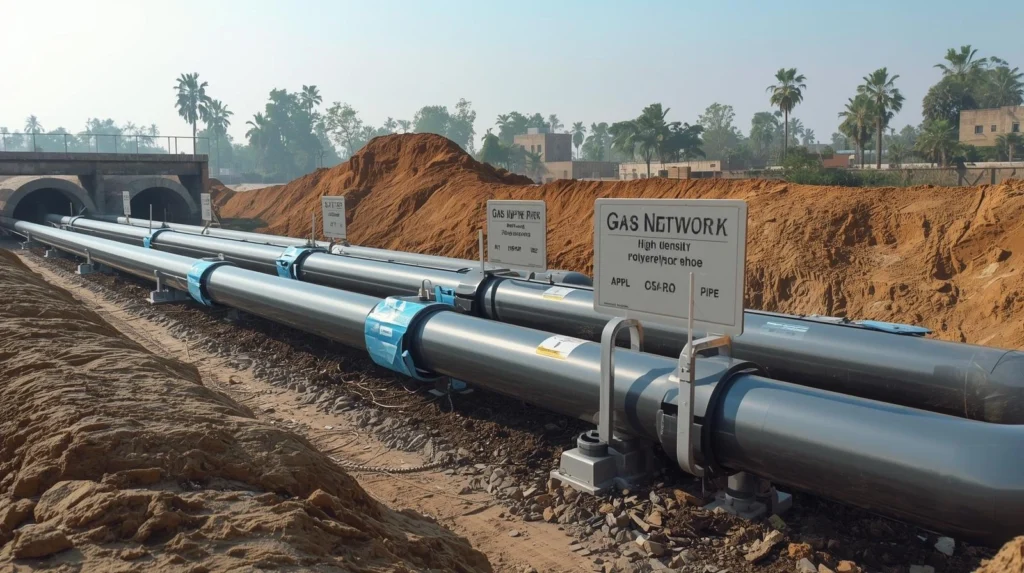A Growing Challenge in Gas Distribution
With Pakistan’s growing urban population and expanding infrastructure, the demand for reliable gas distribution networks has surged. The challenge? Ensuring that gas reaches every home and business in the safest and most efficient manner possible. The answer lies in High-Density Polyethylene (HDPE) pipes.
For years, Pakistan’s gas networks have struggled with outdated materials that are prone to leaks and wear. But HDPE pipes offer a modern solution. They are durable, cost-effective, and resistant to corrosion. In a country like Pakistan, where the gas demand is growing rapidly, transitioning to HDPE pipes is not just a smart choice — it’s a necessary one. In this article, we will explore why HDPE pipes are becoming the preferred solution for gas distribution in Pakistan and how they address the country’s specific needs.
What Makes HDPE Pipes Ideal for Gas Networks?
1. Unmatched Durability for Harsh Conditions
Pakistan’s gas distribution systems are exposed to various challenges, from fluctuating temperatures to aggressive soil conditions. HDPE pipes are specifically designed to handle such stresses. They are resistant to corrosion, which makes them ideal for underground installations, where other materials like steel and PVC would eventually succumb to rust or degradation.
HDPE pipes’ flexibility also allows them to withstand ground movement, which is common in areas prone to earthquakes or soil shifts. These qualities make them far more reliable in the long term compared to traditional materials.
Pro Tip: When planning gas networks, always prioritize HDPE pipes in areas where soil conditions or seismic activity pose a risk to less durable piping materials.
2. Cost-Effectiveness
For any infrastructure project, cost is always a significant factor. HDPE pipes, although initially priced higher than some alternatives, offer cost savings in the long term due to their durability and low maintenance needs. The material’s resistance to corrosion and wear reduces the frequency of repairs and replacements, ultimately saving both time and money for gas network operators.
Additionally, the installation process of HDPE pipes is faster and less labor-intensive compared to traditional metal or concrete pipes. This results in lower overall project costs, particularly in areas with complex terrain or harsh climates.
Expert Insight: “By shifting to HDPE pipes, gas companies in Pakistan can save up to 30% on operational costs over the lifespan of the infrastructure, thanks to fewer repairs and longer-lasting materials.” – Industry Expert
3. Leak Prevention and Enhanced Safety
One of the most critical factors in gas distribution systems is preventing leaks, as they can lead to safety hazards. HDPE pipes are manufactured with smooth inner surfaces and are welded together using fusion methods, which create a monolithic structure without joints that could weaken over time. This significantly reduces the risk of leaks, a common problem with older pipes that have multiple fittings and joints.
In a country like Pakistan, where gas leaks can cause catastrophic explosions, the safety aspect of HDPE pipes cannot be overstated. The low risk of leakage combined with their flexibility and strength offers gas network operators peace of mind, knowing their systems are more secure.
4. Resistance to Chemicals and Abrasive Materials
Gas networks often face exposure to various chemicals and abrasive materials, especially during construction or from soil infiltration. HDPE pipes are highly resistant to these elements. Their composition ensures they can withstand the stresses from chemical substances found in the ground without degrading. This makes them suitable not only for natural gas but also for other potentially hazardous gases, further extending their utility in different sectors.
Actionable Takeaway: Always check the chemical composition of the soil and surrounding environment to ensure the chosen material can handle potential contaminants. HDPE pipes offer a robust solution in environments where metal pipes might degrade.
5. Environmental Benefits and Sustainability
Pakistan faces increasing challenges related to environmental degradation, and the gas distribution industry is no exception. HDPE pipes are made from recyclable materials, making them an environmentally friendly choice compared to other non-recyclable options. Additionally, their longer lifespan means fewer pipes need to be manufactured and replaced, reducing waste over time.
The ability to recycle HDPE pipes also adds to their sustainability credentials, which is increasingly important in today’s eco-conscious world. Moreover, by reducing the frequency of repairs and replacements, HDPE pipes contribute to reducing the carbon footprint of gas network operations.
6. Easier Installation and Reduced Downtime
Traditional pipe installation methods can be time-consuming, requiring large labor forces and extensive planning. However, HDPE pipes offer significant advantages in terms of ease of installation. Their lightweight nature makes them easier to transport, while their flexibility means they can be bent and adjusted to fit the terrain, reducing the need for expensive fittings.
Additionally, fusion welding techniques used to join HDPE pipes provide a strong, leak-proof connection, further simplifying the installation process. For a country like Pakistan, where time is of the essence, this can drastically reduce downtime and improve the efficiency of gas distribution networks.
Case Study: In the city of Lahore, the local gas company switched to HDPE pipes in a pilot project, reducing installation time by 40% compared to traditional methods and cutting maintenance costs by 20% within the first year.
High-Quality Pipes & Fittings – Built to Last
Real-World Examples: HDPE Pipes in Action
Case Study 1: Karachi’s Expanding Gas Network
Karachi, Pakistan’s largest city, is constantly expanding its gas distribution network to meet the demands of its growing population. The city has increasingly turned to HDPE pipes for new installations, with remarkable results. Not only has this shift improved safety and reliability, but the reduced need for frequent repairs has allowed for smoother operations across the network.
Case Study 2: Rural Development in Punjab
In rural areas of Punjab, where natural gas networks are expanding rapidly, HDPE pipes have proven to be a more cost-effective solution than the traditional steel pipes previously used. The material’s ability to withstand harsh environmental conditions, such as high moisture content in the soil and fluctuating temperatures, has ensured the longevity and performance of the infrastructure.
Conclusion: Why HDPE Pipes Are the Future of Gas Distribution in Pakistan
As Pakistan continues to face rapid urbanization and increased demand for gas, HDPE pipes stand out as the most effective, safe, and cost-efficient solution for modern gas distribution networks. Their durability, resistance to corrosion, and environmental benefits make them an ideal choice, especially in a country like Pakistan, where the gas network infrastructure is constantly under pressure.
By adopting HDPE pipes, Pakistan can not only enhance its gas distribution efficiency but also create a more sustainable and safe network for the future. Gas operators should strongly consider this technology as they plan for the growing demands of the next generation.
Call to Action: If you’re involved in gas network planning or management, it’s time to evaluate HDPE pipes for your upcoming projects. Consult with industry experts to explore the best installation practices and ensure your network is built for the future.
FAQ Section
1. What are the main advantages of HDPE pipes for gas distribution?
HDPE pipes are durable, cost-effective, resistant to corrosion, and provide leak-proof connections. They are ideal for gas networks, offering long-term reliability and safety.
2. Are HDPE pipes better than steel for gas distribution?
Yes, HDPE pipes are more resistant to corrosion and wear, have longer lifespans, and are easier to install compared to steel pipes.
3. Can HDPE pipes be used in all types of soil?
Yes, HDPE pipes are highly adaptable and can withstand harsh soil conditions, making them a great choice for diverse environments.
4. How do HDPE pipes prevent gas leaks?
HDPE pipes are welded using fusion techniques, which eliminate joints and create a continuous, strong structure that significantly reduces the risk of leaks.
5. Are HDPE pipes sustainable?
Yes, HDPE pipes are made from recyclable materials and have a long lifespan, making them a sustainable choice for gas distribution networks.
6. What is the expected lifespan of HDPE pipes?
HDPE pipes can last for over 50 years when properly maintained, making them a long-term investment for gas distribution systems.


